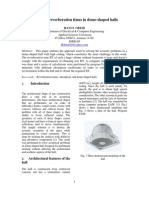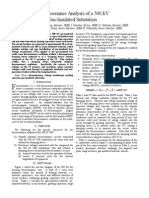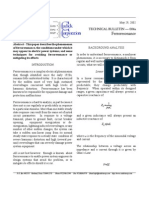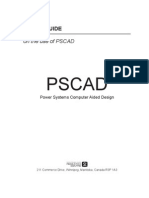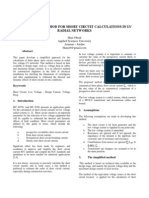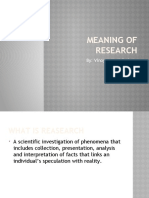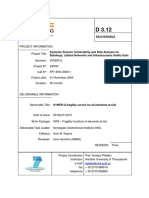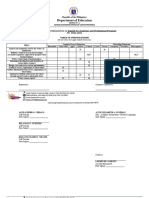Ferroresonance at Open Phase Operating Conditions
Ferroresonance at Open Phase Operating Conditions
Uploaded by
haiobCopyright:
Available Formats
Ferroresonance at Open Phase Operating Conditions
Ferroresonance at Open Phase Operating Conditions
Uploaded by
haiobCopyright
Available Formats
Share this document
Did you find this document useful?
Is this content inappropriate?
Copyright:
Available Formats
Ferroresonance at Open Phase Operating Conditions
Ferroresonance at Open Phase Operating Conditions
Uploaded by
haiobCopyright:
Available Formats
FERRORESONANCE AT OPEN PHASE OPERATING CONDITIONS OF POWER TRANSFORMERS
Hani Obeid
Electrical & Computer Department, Faculty of Engineering, Applied Sciences University, Amman, Jordan Abstract: The reliability of electric supply to consumers is one of the most important factors that determine the requirements imposed on modern utility companies. This paper presents the results of investigation by computer software of the overvoltages resulting from a ferroresonance conditions in MV networks at open phase operating condition with and without connection to earth on source and load sides of distribution transformer. This overvoltage may reach 4.2 pu on one of the HV side of transformer unswitched phases. The results of the study show that ferroresonance overvoltage may be controlled by replacing fuses with circuit breakers on HV side to ensure switching-off all phases. Insertion of resistor or reactor in the neutral of source and load sides of the transformer with 5% active load will help in suppressing overvoltages. Keywords: Ferroresonance, Over Voltage , open Phase operating Condition, Non-linear Inductance.
1. Introduction1
The resonance in a linear circuit containing inductance and capacitance is well known phenomena. Analytical description of the transient processes in a linear circuit can be obtained by solving a system of linear differential equations, and the solution is clearly straightforward [1,2]. The resonant frequency for known values of inductance and capacitance can be predicted. This resonance effect presents one stable operational state, and its effects are mitigated by the system frequency control or by the introduction of pure resistance [3] or use of three-phase switchgear instead of fuses [4]. In complex three-phase circcuits with nonlinear elements, such as transformer core, analytical analysis of transient processes (ferroresonance) are usually impossible. Graph-analytical method of analysis gives qualitative understanding of the possible states of the circuit and the approximate value of the variable voltage on elements for the simple series connection of and in a circuit. The analysis of series ferroresonance is given in [1,5]. Many studies were performed in recent years to predict overvoltages and currents as a result of ferroresonance processes [6,7,8]. It should be stated here that the only practical and reliable way to study ferroresonance phenomena in three-phase networks is by modeling of transient
*
processes by computer software. These softwares should have the possibility of modeling the three-phase magnetic systems with the solution of systems of electrical and magnetic transient processes at the same time. One of these programs is intended for the calculation of transients in arbitrary schemes of electric circuits containing active resistance, inductance, capacitance, voltage and current sources, switches, controlled semiconductor valves, non-linear active resistance of arcs, and complex model of feromagnetic devices. The diagram of magnetic circuit and electrical connection of transformer windings can be arbitrary. The data required for such program are: geometrical dimensions of ferromagnetic cores (length and cross-sections), the location of the windings on the magnetic system, active resistance and number of turns. The above mentioned program was used to study ferroresonance in distribution network of 6-35 KV. In this paper, the results of investigating the ferroresonance at open phase operating conditions of power transformer are presented.
2. The Equivalent Diagram
In MV network, where the winding of the step-down transformer is connected in delta-wye to ground, the open phase operating condition may occur as a result of fuse burn-out in one or two phases at high voltage side of transformer, incomplete phase switching on,open and drop wires of overhead lines at load side [3,6]. As a result, frroresonance can cause sustained overvoltages which are dangerous for distribution equipment [7].
Corresponding author: Hani Obeid, associate professor. Email: Haniob@gmail.com
Fig. 1 represents the equivalent circuit for computer modeling of ferroresonance for noncomplete switching on one of the phases, with open conductor near source or open conductor near load with or without earth connection. Open phase operating condition in this case may be combined with one of the phases connected to earth on the source or load side (this is the case where one of wires of the overhead lines is dropped to earth). The LVwinding of the transformer 6/0.4 KV is connected in wye to ground and the neutral is unloaded.
Fig. 2 shows ferroresonance process at open phase operating condition (switching on of two phases while the other phase is open and connected to ground on HV side) of 6/0.4 KV, / Y to ground, 1000 KVA transformer, when the capacitive current of the network is equal to 15A. It was found that insertion of reactor in the neutral of the transformer on the supply side will eliminate ferroresonance overvoltage when open phase operating condition occurs without connection to earth. If the unswitched on phase is connected to earth (switch B is closed in Fig. 1), which is a limit case, over voltage appearing as a result of ferroresonance will not differ from the case discussed above. The only difference is that insertion of reactor in the neutral will not eliminate overvoltage, because the current path will consist of non-linear inductance of the transformer and capacitive to earth in point of earth connection (switch B is closed). In both cases, the insertion of resistor in the neutral of source supply will not affect the ferroresonance overvoltage. The most important factor in this case will be the loading of transformer at LV side. If the transformer is loaded with active load equals to 0.01 of its rated capacity the overvoltage as a result of ferroresonance will disappear.
3. Ferroresonance Overvoltage as a Result of Unswitched-on Phase on Source Side
In operating condition of two-phase switching of transformer (the other phase is open without connection to earth), the over voltage will reach 4.2 p.u. on one of the HV side of transformer phases (unswitched) when the capacitive current of the supply transformer is equal to 0.7 A. It is interesting to note that overvoltage on stepdown transformer 6/0.4 KV will reach 2.7 p.u. on two phases at small loading condition of transformer (at night condition when the load of transformer is small). That will lead to damage of home appliances and devices.
Open conductor
Open conductor
Fig. 1 Equivalent circuit for comsputer simulation
Voltage on 6 KV side. o.e = p.u, KB = KV
Voltage on 0.4 KV side
Voltage on neutral of the source
Fig. 2 Ferroresonance process of 250 KVA, 6/0.4 KV, /Y-0 transformer when two phases are switched on a cable of 0.7 A capacitive current in a network of 30A capacitive current.
4. Ferroresonance Overvoltage as a Result of Unswitched-on Phase on /load Side
In case of open phase operating condition on load side with connection to earth (refer to Fig.1, where switch B2 is closed), ferroresonance overvoltage of 5 p.u. will appear on source side, while overvoltage of 2.9 p.u. will appear on load side. In this case overvoltage will appear also on the neutral of source supply. Monitoring of insulation by using an indicator of will indicate such a fault, but the large value of overvoltage (even for seconds) will damage voltage transformer and distroy the insualtion of the network. On of the effective measures to be taken in mitigating a. In order to avoid such open phase operating conditions it is recommended to protect the transformer with circuit breakers instead of fuses, specially for networks with high capacitive currents, or to make sure that all phases on the source side will be opened in case one of the fuses burns out. b. The dangerous results of ferroresonance overvoltage in case of open wire on load side
overvoltage will be insertion of active resistance in the neutral of power source. Fig.3 shows ferroresonance process and overvoltages on source, load sides of transformer, and neutral of power source for 6/0.4 KV, / Y to ground, 1000 KVA transformer, when capacitive current of the network is equal to 15A. The results of investigations and computer simulation show that certain measures should be taken to ensure that overvoltage as a result of ferroresonance is controlled and mitigated to safety levels. It is recommended to apply the following measures: with drop-out to earth may be avoided if we insert a resistor or raector in the neutral of source supply. Ir is recommended to connect permanently active load on the load side of transformer (0.4 Kv side) in the value of 5% 0f the rated capacity of transformer.
c.
Voltage on 6 KV side. o.e = p.u, KB = KV
Voltage on 0.4 KV side
Voltage on neutral of the source
Fig. 3 Ferroresonance process of 1000 KVA, 6/0.4 KV, /Y-0 transformer when two phases are switched on and the third phase is open and connected to ground on the load side in a network of 15A capacitive current.
5. Conclusions
Open phase operating condition with and without connection to earth on source and load side of distribution 6/0.4 KV transformer were investigated by computer simulation. In both cases a dangerous overvoltage as a result of ferroresonce will appear which might damage voltage transformers, insulation of the network and home appliances. It is recommended to use circuit breakers instead of fuses on HV side to ensure interrupting of three phases in case of unswitched one of the phases. It is also recommended to insert resistor or raector in the neutral of source side. Also, the transformer must be loaded with active load, which is not less than 5% of rated transformer capacity. current with transformer parameters such as voltage impedance and rated current.
References
[1] L. P. Nieman, K.S. Demerchain. Theoritical fundamentals of electrotechnology. Energia Publishers, Moscow (1967).
[2] Arieh L. Shenkman. Transients of electric power circuits handbook. Springer, Netherlans (2005). [3] V. Velverde, A.J. Mazon, I. Zamora, G. Buigues. Ferroresonance in voltage transformer: analysis and simulation. Research team of Project UE03/A0, University of the Basque Country. [4] Roger C. Dugan. Examples of ferroresonance in distribution systems. Panel Summary prepared at the request of the Practical Aspects of Ferroresonance Working Group of the Transmission & Distribution Committee. [5] R. Rudenberg. Transient performance of electrical power systems. 1st edition, London, 1950. [6] A.S. abdallah, M.A. El-kady. Ferroresonance phenomenon in power transformers-experimental assessment. JKAU : Eng. Sci., Vol. 16 no. 1, pp. 71-82 (2005 A.D./1426 A.H.). [7] Ahmet Nayer, A.R. Babayeva, E.V. Dmitryev, A.M. Hashimov, I.R. Pivchik. Mathematical modelling of ferrresonance for investigation of ferroresonance currents. Journal of electrical & electronics engineering, Vol.. 5, No. 2 (2005). [8] G. Buigues, I. Zamora, V. Valverde, A.j. Mazon, J.I. San Martin. Ferroresonance in three-phase power distribution transformers: sources, consequences and prevention. CIRED, 19th International Conference on Electricity Distribution, Vienna, 21-24 ( 2007).
You might also like
- Good Clinical PracticeDocument21 pagesGood Clinical PracticeanisaishakNo ratings yet
- The Technology of Instrument Transformers: Current and Voltage Measurement and Insulation SystemsFrom EverandThe Technology of Instrument Transformers: Current and Voltage Measurement and Insulation SystemsNo ratings yet
- Networking Assignment1 Fontsheet 1Document43 pagesNetworking Assignment1 Fontsheet 1Dương Bùi Thái100% (1)
- Mountain HighDocument26 pagesMountain HighQuercusBooksNo ratings yet
- A Transfer Function Approach To Harmonic Filter DesignDocument15 pagesA Transfer Function Approach To Harmonic Filter DesignvgarudaNo ratings yet
- Power Transformers and ReactorsDocument49 pagesPower Transformers and ReactorsroyclhorNo ratings yet
- IEE Wiring RegulationsDocument64 pagesIEE Wiring Regulationshaiob50% (2)
- Control of Reverberation Times in Dome1Document4 pagesControl of Reverberation Times in Dome1haiobNo ratings yet
- Capacitor DigsilentDocument5 pagesCapacitor DigsilentAnonymous SXkhNw2wENo ratings yet
- Examples Ferroresonance in High Voltage Power System: N. Jacobson, Membec IEEEDocument7 pagesExamples Ferroresonance in High Voltage Power System: N. Jacobson, Membec IEEE_FlyMan_No ratings yet
- Influence of Sympathetic Inrush On Voltage DipsDocument12 pagesInfluence of Sympathetic Inrush On Voltage Dipsbedabrat13No ratings yet
- On The Problem of Shunt Reactor Tripping During Singl and Three Phase Auto ReclosingDocument6 pagesOn The Problem of Shunt Reactor Tripping During Singl and Three Phase Auto ReclosingCarlos Lino Rojas AgüeroNo ratings yet
- SCE PSCAD Library Component Third Quarter Report: Senior Design 2014-2015Document62 pagesSCE PSCAD Library Component Third Quarter Report: Senior Design 2014-2015syafiqishamuddinNo ratings yet
- Auto Transformer Insulation Coordination StudyDocument6 pagesAuto Transformer Insulation Coordination StudyrajfabNo ratings yet
- Energy Stress On Surge ArresterDocument6 pagesEnergy Stress On Surge Arresterpartha_gang4526No ratings yet
- Ferroresonance VT Gis v002Document4 pagesFerroresonance VT Gis v002qais652002No ratings yet
- Energising Inrush Current Transients in Parallel-Connected TransformersDocument5 pagesEnergising Inrush Current Transients in Parallel-Connected TransformersagusraposobustoNo ratings yet
- Busbar Protection - Busbar Differential: Best Practice and RecommendationsDocument57 pagesBusbar Protection - Busbar Differential: Best Practice and RecommendationsKanagaraj RaviNo ratings yet
- Analysis of Active Power Flow Control With Phase Shifting Transformer in AC Transmission LineDocument7 pagesAnalysis of Active Power Flow Control With Phase Shifting Transformer in AC Transmission LineEditor IJTSRDNo ratings yet
- Transient Recovery Voltages in Vacuum Circuit Breakers Generated by The Interruption of Inrush Currents of Large Motors (IPST)Document8 pagesTransient Recovery Voltages in Vacuum Circuit Breakers Generated by The Interruption of Inrush Currents of Large Motors (IPST)cool_saklshpurNo ratings yet
- Power Quality Improvement by Using STATCOM Control PDFDocument11 pagesPower Quality Improvement by Using STATCOM Control PDFيوسف خضر النسورNo ratings yet
- Transient Stability Improvement of SMIB With Unified Power Flow ControllerDocument78 pagesTransient Stability Improvement of SMIB With Unified Power Flow ControllerRagesh OdungattuNo ratings yet
- Pre-Insertion Resistor of Switching Shunt Capacitor Banks: C L C LDocument7 pagesPre-Insertion Resistor of Switching Shunt Capacitor Banks: C L C LbyjuvcNo ratings yet
- Harmonic Resonance During Energizing Primary Restorative Transmission SystemsDocument14 pagesHarmonic Resonance During Energizing Primary Restorative Transmission SystemsLuKas21cNo ratings yet
- IPSA POWER A Guide To The DC Decay of Fault Current and XR RatiosDocument10 pagesIPSA POWER A Guide To The DC Decay of Fault Current and XR RatiosMiko F. RodriguezNo ratings yet
- Power System Stabilizers For The Synchronous Generator: Tuning and Performance EvaluationDocument78 pagesPower System Stabilizers For The Synchronous Generator: Tuning and Performance EvaluationVikas PatelNo ratings yet
- Magnetic Saturation PDFDocument6 pagesMagnetic Saturation PDFDaniel MemijeNo ratings yet
- Transient Overvoltages and Insulation CoordinationDocument9 pagesTransient Overvoltages and Insulation CoordinationCristian Santana Rodriguez0% (1)
- 1400HP - 11kV Motor Data Sheet (WEG)Document5 pages1400HP - 11kV Motor Data Sheet (WEG)Sandeep Parti100% (1)
- Power Transformer Application For Wind Plant Substations: IEEE PES Wind Plant Collector System Design Working GroupDocument6 pagesPower Transformer Application For Wind Plant Substations: IEEE PES Wind Plant Collector System Design Working GroupCésar Díaz LiberonaNo ratings yet
- Flashover Model of Arcing Horn in Transient SimulationDocument5 pagesFlashover Model of Arcing Horn in Transient SimulationNovia Khoirul AnnisaNo ratings yet
- How To Manage Transformer Inrush CurrentDocument8 pagesHow To Manage Transformer Inrush CurrentSchwarz ChimunhuNo ratings yet
- ATPEMTP Study of Ferroresonance Involving HV InducDocument5 pagesATPEMTP Study of Ferroresonance Involving HV InducAhmad Thoriq Maudrey KabarekNo ratings yet
- Ferroresonance CalculationDocument8 pagesFerroresonance Calculationwildtrek0% (1)
- PowerFactory EMT Model3Document6 pagesPowerFactory EMT Model3Ratana KemNo ratings yet
- Flexible AC Transmission Syste MS: FactsDocument29 pagesFlexible AC Transmission Syste MS: FactsPrakash MahendranNo ratings yet
- Static Compensator Statcom PDFDocument37 pagesStatic Compensator Statcom PDFLeibniz Miranda100% (2)
- Monitoring of Transient Overvoltages On The Power Transformers and Shunt ReactorsDocument14 pagesMonitoring of Transient Overvoltages On The Power Transformers and Shunt ReactorsParantap RahaNo ratings yet
- VCB Transients Study.Document6 pagesVCB Transients Study.Shiju Kp.No ratings yet
- HVDC Ground ElectrodeDocument13 pagesHVDC Ground ElectrodeHeather CarterNo ratings yet
- Air Gap Inductance Calculation For Transformer Transient ModelDocument3 pagesAir Gap Inductance Calculation For Transformer Transient ModelMurat Erhan BalciNo ratings yet
- 03 - Power System Analysis FunctionsDocument168 pages03 - Power System Analysis FunctionsgjanitoNo ratings yet
- InrushDocument226 pagesInrushDinesh Selvakumar100% (1)
- Multilin: Synchronism Check EquipmentDocument26 pagesMultilin: Synchronism Check EquipmentĐức Nguyễn XuânNo ratings yet
- Transient Recovery VoltageDocument11 pagesTransient Recovery VoltageEzequiel Juarez BenítezNo ratings yet
- Ferro ResonanceDocument8 pagesFerro ResonanceDoydoy MeridaNo ratings yet
- Pscad ManualDocument511 pagesPscad ManualSammie AuduNo ratings yet
- Power System TransientsDocument11 pagesPower System TransientsKhairul AshrafNo ratings yet
- Analysis of Very Fast Transients in Layer-Type Transformer WindingsDocument10 pagesAnalysis of Very Fast Transients in Layer-Type Transformer WindingsZaid Luna LopezNo ratings yet
- Design of 220 KV Substation Grounding GridDocument7 pagesDesign of 220 KV Substation Grounding GridFaisal MoinNo ratings yet
- Dynamic Stability Analysis of Large-Scale Power Systems PDFDocument219 pagesDynamic Stability Analysis of Large-Scale Power Systems PDFMd. Arifur KabirNo ratings yet
- Lightning Critical Flashover VoltageDocument8 pagesLightning Critical Flashover VoltageJosNo ratings yet
- A FACTS Device Distributed PowerFlow Controller (DPFC)Document8 pagesA FACTS Device Distributed PowerFlow Controller (DPFC)narashimamurthyNo ratings yet
- VSC-FACTS-HVDC: Analysis, Modelling and Simulation in Power GridsFrom EverandVSC-FACTS-HVDC: Analysis, Modelling and Simulation in Power GridsNo ratings yet
- Current Interruption Transients CalculationFrom EverandCurrent Interruption Transients CalculationRating: 4 out of 5 stars4/5 (1)
- Grid-Integrated and Standalone Photovoltaic Distributed Generation Systems: Analysis, Design, and ControlFrom EverandGrid-Integrated and Standalone Photovoltaic Distributed Generation Systems: Analysis, Design, and ControlNo ratings yet
- Integration of Green and Renewable Energy in Electric Power SystemsFrom EverandIntegration of Green and Renewable Energy in Electric Power SystemsNo ratings yet
- Ferroresonance During Single-Phase Switching of Distribution TransformersDocument6 pagesFerroresonance During Single-Phase Switching of Distribution TransformersDiego Betancourt MejiaNo ratings yet
- 00296256Document9 pages00296256lamugre20003506No ratings yet
- Viability of Permanent Single-Phase Opening of Lines in Extra High Voltage SystemsDocument5 pagesViability of Permanent Single-Phase Opening of Lines in Extra High Voltage SystemsLong LeoNo ratings yet
- Relay Setting (Directional) : Leakage FluxDocument8 pagesRelay Setting (Directional) : Leakage Fluxjyoti kachareNo ratings yet
- Ground Fault Over VoltagesDocument7 pagesGround Fault Over Voltagespistola2No ratings yet
- Prof. Hani Obeid: Faculty of Engineering Applied Sciences University Lec. # 3Document44 pagesProf. Hani Obeid: Faculty of Engineering Applied Sciences University Lec. # 3haiobNo ratings yet
- Lighting FundamentalsDocument71 pagesLighting FundamentalshaiobNo ratings yet
- Prof. Hani Obeid: Faculty of Engineering Applied Sciences University Lec. # 2Document53 pagesProf. Hani Obeid: Faculty of Engineering Applied Sciences University Lec. # 2haiobNo ratings yet
- Simplified Method For Short Circuit CalculationsDocument4 pagesSimplified Method For Short Circuit Calculationshaiob100% (1)
- Simplified Method For Short Circuit CalculationsDocument4 pagesSimplified Method For Short Circuit Calculationshaiob100% (1)
- Transmission Line ParametersDocument141 pagesTransmission Line ParametershaiobNo ratings yet
- Architectural Acoustics IDocument80 pagesArchitectural Acoustics IhaiobNo ratings yet
- Control of Reverberation Times in DomeDocument5 pagesControl of Reverberation Times in DomehaiobNo ratings yet
- 1st Presenter - Group 6Document34 pages1st Presenter - Group 6Alex LuminariasNo ratings yet
- ZTC - SaifulDocument2 pagesZTC - SaifulSaiful RafiqNo ratings yet
- Pedalpower ppg2 3 1Document7 pagesPedalpower ppg2 3 1ramsinghNo ratings yet
- 10-Benfotiamine FALL 03nDocument14 pages10-Benfotiamine FALL 03nNigel CheungNo ratings yet
- Principles of Crop ProductionDocument6 pagesPrinciples of Crop ProductionJanice VaflorNo ratings yet
- D3.12 - SYNER-G Fragility Curves For All Elements at RiskDocument145 pagesD3.12 - SYNER-G Fragility Curves For All Elements at RiskMohammad AL HaririNo ratings yet
- Polietileno LDF 1925 - HMDocument1 pagePolietileno LDF 1925 - HMMariangela Nava0% (1)
- 1/1.25 MW Inverter Training Course: September 2014Document118 pages1/1.25 MW Inverter Training Course: September 2014khbader499No ratings yet
- Lab 4 - DMFCDocument11 pagesLab 4 - DMFCNeel NadparaNo ratings yet
- Plant Pests: Margaret Chapman Cal Poly, San Luis ObispoDocument24 pagesPlant Pests: Margaret Chapman Cal Poly, San Luis ObispoHeather DoyleNo ratings yet
- Advantages and Disadvantages of Technology in Our Life: Presented:By Group2Document13 pagesAdvantages and Disadvantages of Technology in Our Life: Presented:By Group2Daryn CorpusNo ratings yet
- Elk-4 800 1HZC208015 202111 enDocument16 pagesElk-4 800 1HZC208015 202111 ensameershukur17No ratings yet
- Political Response To Capitalist Crisis Neo-Marxist Theories of The State and The Case of The New DealDocument47 pagesPolitical Response To Capitalist Crisis Neo-Marxist Theories of The State and The Case of The New DealjauncitoNo ratings yet
- 1.4.virtualization 2Document36 pages1.4.virtualization 2pshreyNo ratings yet
- Star Fleet Battles - Sublight Rules 1979Document1 pageStar Fleet Battles - Sublight Rules 1979Anonymous bePwHMl100% (2)
- Asme RimapDocument10 pagesAsme RimapDia Putranto HarmayNo ratings yet
- Character Regulation Bylaws June 27 2022 1Document34 pagesCharacter Regulation Bylaws June 27 2022 1Jheymesson CavalcantiNo ratings yet
- Conceptualizations of Development and Underdevelopment - The Works of Frank and Amin PDFDocument24 pagesConceptualizations of Development and Underdevelopment - The Works of Frank and Amin PDFAnushka AnandNo ratings yet
- Spectacular Examples of Foundation FailuresDocument14 pagesSpectacular Examples of Foundation FailuresEugene CardamaNo ratings yet
- English Grade 3a Part 2Document129 pagesEnglish Grade 3a Part 2wahid bcsNo ratings yet
- Tos - Solo Taxonomy Eapp Q2Document2 pagesTos - Solo Taxonomy Eapp Q2roxannemarie.vidamoNo ratings yet
- FitzmyerDocument18 pagesFitzmyerbajaNo ratings yet
- Inspiration-To-Go Ebooks For You: The Magic StoryDocument15 pagesInspiration-To-Go Ebooks For You: The Magic StoryraostoreNo ratings yet
- NSE Ikeja January 2017 News LetterDocument7 pagesNSE Ikeja January 2017 News LetterbbllngNo ratings yet
- Master Thesis The Development of Autonomous VehiclesDocument116 pagesMaster Thesis The Development of Autonomous Vehiclescristi_pet4742No ratings yet
- Sacfa ProcedureDocument21 pagesSacfa ProcedureSunil Jain67% (3)
- Industrial RevolutionDocument24 pagesIndustrial RevolutionHafsah SiddiquaNo ratings yet







